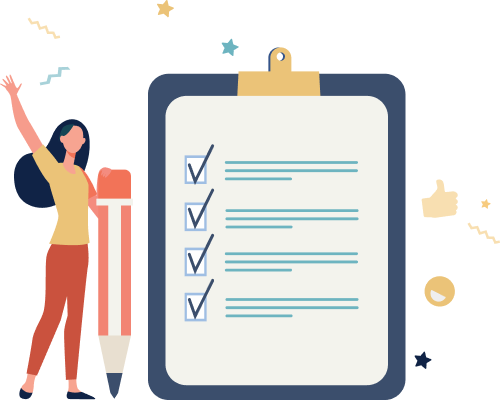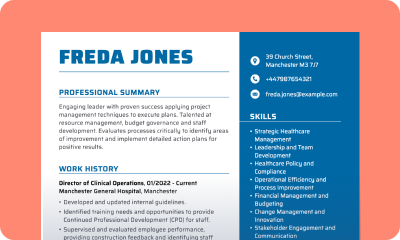How to Write a Great Job Description (Template & Sample)
A job description serves as your company’s first impression. Discover how to write descriptions that highlight your culture, needs, and expectations, ensuring you find the ideal candidates.


Our customers have been hired by: *Foot Note
A job description is your best opportunity to attract the right people. It reflects your organisation’s values, culture, and ambition. It tells candidates not only what you need, but what you stand for.
And just like a well-written CV, the best job descriptions are clear, structured, and personal. They strike a balance between being professional and human, informative yet inspiring.
In this guide, we’ll show employers how to write job descriptions that work—descriptions that don’t just attract applicants, but the right ones. Then, for job seekers, we’ll explain how understanding job descriptions can help you describe yourself on a CV in a way that gets noticed.
What is a job description?
At its core, a job description outlines the purpose, responsibilities, qualifications, and expectations of a specific role within a company. It informs candidates about the role, and it inspires the right ones to apply.
Today’s job seekers are selective, career-minded, are looking for clarity, purpose, and a sense of fit before they apply. That means a rushed, generic job description can cost you the attention of top-tier candidates. In fact, 55% of candidates perceive vague job descriptions as a major red flag, impacting their decision to apply.
What should a job description include?
A great job description communicates the practical details of the role, but also subtly reflects your organisation’s identity. Here are the essential components every job description should include:
Job title
Your job title is your first and most visible opportunity to attract candidates. Be specific, not creative, when providing it. Use recognised terminology to ensure your posting appears in the right search results. Avoid internal-only phrasing (e.g. “Level VI Lead”) that may confuse or alienate job seekers.
Use standard descriptors. Include common seniority levels (e.g. “Junior”, “Mid-Level”, “Senior”) where appropriate. Keep it short, as shorter titles tend to perform better in searches. Also, reflect the function, not just the department. Titles like “Marketing Copywriter” or “HR Data Analyst” are more effective than “Marketer”.
Senior Digital Project Manager
Digital Ninja – Client Solutions
For example:
Job summary
This is your opportunity to introduce the role and your company. Do it by following these 4 principles:
- Start with a hook: In 2–3 sentences, describe the purpose of the role and how it contributes to the wider team or organisation.
- Introduce your company: Mention your mission, size, industry, and what sets your culture apart. This builds emotional appeal early on.
- Include location & work model: Whether it’s hybrid, remote, or office-based, job seekers want this information upfront.
- Mention schedule & hours: Candidates in today’s market value transparency around working patterns and flexibility.
For example:
We’re looking for a proactive Operations Coordinator to support our growing logistics team. Based at our Manchester HQ (3 days per week), this role offers flexible hours and the opportunity to be part of a business redefining urban delivery.
Work responsibilities
This section provides clarity on what the role entails day to day, helping candidates imagine themselves in the position and assess their suitability. The best job descriptions follow these pointers:
- Be detailed but concise: Include 6–10 bullet points focusing on key responsibilities, listed in order of importance.
- Describe daily activities: Give a sense of rhythm, variety, and pace. Present the most common duties first. Candidates need to know what they will be expected to do on a daily basis.
- Clarify hierarchy and scope: Note who the role reports to and whether it involves team leadership, budget oversight, or cross-department collaboration.
- Highlight unique requirements: If the role includes anything not typically associated with the job title, this is where to mention it.
For example:
Job responsibilities:
- Manage internal scheduling across four project teams, ensuring delivery timelines are met
- Liaise with external partners and vendors, overseeing service-level agreements
- Report directly to Head of Operations, attending weekly strategy meetings
- Maintain documentation systems using Trello, SharePoint, and Excel
Required skills and qualifications
This section defines what a successful candidate looks like. The goal is to communicate your expectations while keeping the door open to candidates with relevant, transferable strengths.
To make this section effective and inclusive, consider the following:
- Clearly distinguish between essential and desirable qualifications. This helps candidates self-select more accurately and reduces unnecessary self-elimination from otherwise capable applicants.
- Be precise when naming tools, platforms, programming languages, or methodologies. Specify the systems, software, frameworks, and other hard skills that are relevant to the role.
- Add a few soft skills that reflect how you work as a team and what behaviours are valued in your organisation.
- Define the expected level of work experience.
- List education qualifications only if they are truly necessary. Many roles can be performed well without a university degree, and overly rigid requirements can reduce diversity in your applicant pool.
- Add any bonus qualifications that are expected/desirable, like certifications, known foreign languages, etc.
For example:
Required qualifications:
- 2–3 years of experience in a client-facing project management role
- Strong proficiency in Excel, including pivot tables and dashboards
- Excellent time management and prioritisation skills
- Bachelor’s degree in Business, Marketing, or equivalent experience
- Familiarity with Asana or similar project tracking tools
Good-to-have:
- Experience working in SaaS or B2B environments
- Working knowledge of HTML/CSS
- PMI or PRINCE2 certification
- Fluency in German or French
Working arrangements
Job hunters value transparency, so don’t make them turn into private detectives to find the basics. Clearly state where, when, and how the work happens. Mention:
- Location: Include both the city and whether the role is remote, hybrid, or on-site.
- Schedule: Specify full-time/part-time, fixed or flexible hours.
- Travel: Note any expected travel, frequency, and destinations.
- Team setup: Remote-first? Co-located? Clarify the working culture.
For example:
- Location: Hybrid – 2 days/week in our Leeds office
- Hours: Full-time (37.5 hours), flexible between 8am–6pm
- Remote working: UK-based only
- Occasional travel (1–2 times per quarter) for off-site team events
Salary & benefits
Including a salary range greatly increases transparency, leading to more candidates being interested in the position. It also lowers your recruiting budget, as there will be fewer candidates who will get to, or through, the job interview and reject the offer after learning the salary value.
Transparency also attracts more dedicated candidates, who are less likely to be “bad hires”. And hiring mistakes can cost you even 3x the annual salary of that employee.
To improve the job description’s quality:
- Provide a realistic range: Base it on market rates and internal equity.
- List core benefits like: Pension, holidays, health insurance.
- Highlight unique perks: These could include training budgets, sabbaticals, mental health support, or work-from-anywhere policies.
For example:
- Salary: £38,000–£45,000 depending on experience
- 28 days’ holiday + bank holidays
- Private medical insurance through Vitality
- £1,000 per year learning & development allowance
- Work-from-anywhere policy for up to 4 weeks per year
Application details
Clearly outline what candidates should prepare, how and when to submit it, and what happens next. Clear instructions help save time and increase your chances of hearing from the people you actually want to hire.
The details you want to include are:
- What to submit: CV, cover letter, portfolio, reference list.
- How to submit: Via email, specific job board, etc.
- Deadline: If you’re only accepting up to a certain point in time.
- Next steps: Briefly outline the process—interviews, tasks, timelines.
- Point of contact: Humanise the process by naming the hiring team or contact person.
For example:
To apply, please send your CV and a short cover letter to hiring@companymail.com by 17 June 2025. Our Hiring Manager – Name Surname – will be reviewing applications on a rolling basis, and shortlisted candidates will be invited to a video interview the following week.
Job description template
Job Title
[Insert clear, specific title e.g. “Marketing Coordinator”]
Company Overview
[Company Name] is a [size], [industry] company based in [location], committed to [mission or unique value proposition]. We’re known for [what sets you apart] and are proud to offer a supportive, forward-thinking environment where great people thrive.
Job Summary
We’re looking for a [seniority level, e.g. “mid-level”] [job title] to join our [team/department]. In this role, you’ll be responsible for [key purpose of the role], working closely with [who they’ll collaborate with] to achieve [key outcomes or goals].
Responsibilities
- [Responsibility 1]
- [Responsibility 2]
- [Responsibility 3]
- [Responsibility 4]
- [Responsibility 5]
Required Skills & Qualifications
Must-have:
- [Skill or experience 1]
- [Skill or experience 2]
- [Technical/tool knowledge]
- [Minimum education or years of experience]
Nice-to-have:
- [Optional tool, experience, or soft skill]
- [Preferred certification or qualification]
Location & Working Arrangements
- Location: [City or Remote]
- Working Model: [On-site / Hybrid / Remote]
- Schedule: [Full-time / Part-time], [working hours or flexibility details]
- Travel Requirements (if any): [e.g. “Occasional travel to client sites (10%)”]
Salary & Benefits
- Salary Range: [e.g. £38,000–£45,000 depending on experience]
- Holidays: [e.g. 25 days + bank holidays]
- Key Benefits: [e.g. Private health cover, pension scheme, wellness days, etc.]
How to Apply
To apply, please submit [Specify required documents] to [email or application portal] by [application deadline]. Shortlisted candidates will be contacted [timeframe] and invited to [interview format or next step].
If you have any questions, please contact [Hiring Manager/HR contact + email].
Best tips & common mistakes to avoid in job descriptions
A job description that feels generic, vague, or overly rigid can push top talent away before they’ve even started reading your benefits package. Have a look at this side-by-side view on what to do and avoid when creating a high-converting job description:
Use clear, searchable job titles aligned with industry norms
Start with a short, engaging summary of the role and your company
Be transparent about location, hours, flexibility, and work environment
Write responsibilities using action verbs and measurable outcomes
Distinguish between essential and desirable qualifications
Include tools, platforms, and technologies relevant to the role
Be mindful of the tone. Match it to your company culture
Keep the structure consistent: headings, spacing, and bullet formatting
Use inclusive language and avoid biased phrasing
Make the application process clear, concise, and respectful of the candidate’s time
Using internal titles or jargon like “Associate Level VI”
Jumping straight into responsibilities with no context
Leaving key details vague or omitting them entirely
Listing tasks passively or using overly general phrases like “handles duties”
Presenting a long list of demands with no priority
Using generic terms like “tech-savvy” or “good with computers”
Mixing overly formal with overly casual language
Creating dense blocks of text that are hard to scan
Using gender-coded words or cultural assumptions unintentionally
Requesting unnecessary materials or failing to outline next steps
How to read a job description
Behind every perfect CV is a well-read job description. That’s because each job description serves as a blueprint for the candidate, and the best candidates don’t simply scan them for eligibility. They analyse, reflect, and adapt, crafting their CV to mirror what the employer truly wants.
Here’s how you can do the same.
1. Start by reading between the lines
Don’t just skim the responsibilities—read the whole job description thoroughly. Focus on these areas:
- The first few responsibilities listed often signal the highest priorities. Mirror these in your own CV’s work experience section.
- Repeated keywords or phrases (like “client-facing” or “data-led decisions”) suggest key values or expectations. Most CVs today are checked by ATS (applicant tracking systems) before they reach a human. That means using the right keywords is essential.
- Soft skills and tone (e.g. “fast-paced”, “collaborative”, “autonomous”) reveal the kind of work environment you’re stepping into. Reflect this tone in your CV personal statement.
2. Shape your experience
Each responsibility in the job description is an opportunity to show alignment in your work history. Structure your job bullets to echo the employer’s needs and wants.
3. Use the same tone and reflect the company culture
If the job description feels formal, use a more professional tone throughout your CV. If it’s conversational and creative, don’t be afraid to add a bit more personality.
You’re not just applying to a role, but to a team and a culture. Aligning your tone shows you understand (and fit) their environment.
4. Tailor each CV
You don’t need to rewrite your entire CV every time. Instead, adjust your CV profile to reflect the priorities in the job description. Next, restructure your bullet points to highlight the most relevant experience. Finally, reorder your hard and soft skills to match each job description.
Key Takeaways
Whether you’re writing a job description or tailoring your CV to one, clarity, intention, and personalisation make all the difference. The job description is a signal. A message to the right person that says: “You belong here.”
For employers:
- A job description is your first impression. It communicates your company culture, expectations, and professionalism before you ever speak to a candidate.
- Structure matters. A clear, well-organised format with specific responsibilities, qualifications, and work details results in better-quality applications.
- Transparency builds trust. Including salary ranges, location, and working arrangements improves candidate engagement and application rates.
- Language shapes perception. Inclusive, plain-language job descriptions attract more diverse talent and reduce drop-off from qualified applicants.
- Stand out by being specific and human. Avoid jargon and overly generic lists—show candidates why this role matters and why they should care.
For job hunters:
- Every job description is a roadmap. It reveals what the employer values, what they expect, and what success looks like in the role.
- Reading deeply gives you an edge. Spot keywords, tone cues, and hidden priorities to shape a CV that speaks directly to the role.
- Tailoring beats generalisations. Reflecting the job’s language and structure in your CV shows attention to detail.
- Your CV should echo their ask. Mirror responsibilities, align your experience, and let the job description guide how you present your strengths.

Mariusz Wawrzyniak
Content Writer
Mariusz is a career expert at MyPerfectCV who writes practical, research-based guides that help professionals from all industries craft impactful CVs, write compelling cover letters, and advance their careers.
*The names and logos of the companies referred to above are all trademarks of their respective holders. Unless specifically stated otherwise, such references are not intended to imply any affiliation or association with myperfectCV.










